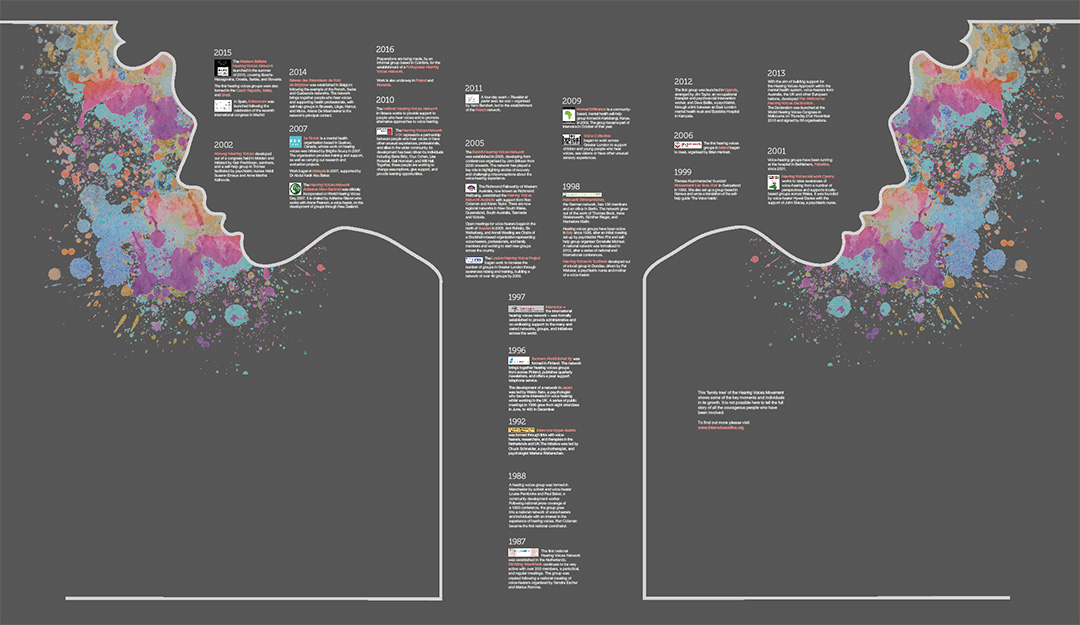Millennial voices: An international people’s movement
The development of the Hearing Voices Movement in the late twentieth century saw the beginnings of a radical shift in the way voice-hearing is conceived of and understood.
What is the Hearing Voices Movement?
What it means to be someone who hears voices has changed significantly for many people as a result of the work of the Hearing Voices Movement.
Many individuals who have found their voices distressing and sought the help of mental health services have been given a psychiatric diagnosis. Commonly the diagnosis is schizophrenia, one of psychiatry’s most hotly contested concepts, and arguably one of the most stigmatizing diagnoses a person can receive. For both clinicians and members of the public, it has been associated with long term incapacity, deterioration and dysfunction, and is often incorrectly linked to violence and dangerous behaviour.
The Hearing Voices Movement has created room for people who hear voices to challenge or reject the psychiatric labels given to them by opening up spaces in which the meaning of someone’s voices can be explored and understood in relation to what has happened to them rather than what is ‘wrong’ with them. It has also paved the way for the use of the term ‘voice-hearer’ as a ‘’, the adoption of which is a source of hope and pride, rather than stigma and shame.
The Hearing Voices Movement is:
… part of a living movement of solidarity and mutual respect, which comes as a response to the one-sidedness of biological approaches. We are, thus, a political and a multi-cultural movement. The experience of voices is not a personal, but a collective matter: it concerns family, friends, professionals, the whole society. We walk together in crisis, we seek common paths of recovery in an Odyssey where the personal becomes collective and the collective becomes personal.
Thessaloniki Declaration (2014)

Photo of delegates at the 2014 World Hearing Voices Congress in Thessaloniki, Greece.
The origins of the HVM
Patsy finally convinced Romme to accept the reality of her voices and to help her to make sense of her experiences. In 1987, with the help of journalist , they appeared on Dutch television to publicise a new approach to voice-hearing. According to this approach:
- Hearing voices is a common aspect of human experience, which can be distressing but is not inherently a symptom of illness; and:
- Voices bear messages about underlying emotional truths and problems, which, with understanding and appropriate support, it is possible to resolve.
After the screening, hundreds of people phoned in to the programme, 450 of whom reported hearing voices. The world’s first Hearing Voices Congress was held in Holland later that year, and from there an international voice-hearing movement spread first to the UK, which now has a network of over 180 hearing voices groups, and then to Europe, Australia, America and beyond.
One of the most important outcomes of the collaboration between Romme, Escher and Patsy Hage was establishing from the very beginning of the HVM the principle that those who hear voices are experts in their own experience and should lead the process of exploring and addressing that experience. This key tenet of the HVM has gone on to influence the joint development and practice, by voice-hearers and mental health professionals, of different ways of working with the experience of hearing voices.
A Family Tree (1987–2016)
Explore the development of the Hearing Voices Movement through this ‘family tree’, which shows some of the key movements and individuals in its growth. It is not possible here to tell the full story of all the people who have been involved.
To download a PDF of the family tree and get a closer look, please click on the image above (Warning: This file is 8MB and may take a while to download).
Image credit: Hearing Voices Movement Family Tree (1987-2016) by Carolyn Gaw, Durham University.
‘I am a voice-hearer’: A positive political identity
What it means to be someone who hears voices has changed significantly for many people as a result of the work of the Hearing Voices Movement.
Many individuals who have found their voices distressing and sought the help of mental health services have been given a psychiatric diagnosis. Commonly the diagnosis is schizophrenia, one of psychiatry’s most hotly contested concepts, and arguably one of the most stigmatizing diagnoses a person can receive. For both clinicians and members of the public, it has been associated with long term incapacity, deterioration and dysfunction, and is often incorrectly linked to violence and dangerous behaviour.
The Hearing Voices Movement has created room for people who hear voices to challenge or reject the psychiatric labels given to them by opening up spaces in which the meaning of someone’s voices can be explored and understood in relation to what has happened to them rather than what is ‘wrong’ with them. It has also paved the way for the use of the term ‘voice-hearer’ as a ‘’, the adoption of which is a source of hope and pride, rather than stigma and shame.
I’m now very proud to be a part of Intervoice, the organizational body of the International Hearing Voices Movement, an initiative inspired by the work of Professor Marius Romme and Dr. Sandra Escher, which locates voice hearing as a survival strategy, a sane reaction to insane circumstances, not as an aberrant symptom of schizophrenia to be endured, but a complex, significant and meaningful experience to be explored. Together, we envisage and enact a society that understands and respects voice hearing, supports the needs of individuals who hear voices, and which values them as full citizens.
Eleanor Longden, The voices in my head
Case study: Rachel Waddingham
Rachel (Rai) Waddingham specialises in working with people who hear voices, see visions, have unusual beliefs, or are dealing with the impact of complex trauma. She is a doctoral researcher and currently Chair of the English Hearing Voices Network. In 2009, Rai helped to set up the Voice Collective project at Mind in Camden, which supports children and young people who hear voices. A year later, she helped to set up a project developing Hearing Voices Groups within prisons and secure forensic settings. A voice-hearer herself, Rai uses her own experiences as both a tool to help others and a reminder of what needs to change in our world.
Growing up, Rai lived in multiple worlds. In one, she was a gifted child with a family who loved her. In another, she was a monster, an alien, something dangerous. She kept this hidden world a secret, just as she hid the abuse. Although this abuse happened outside of her family, it cut deeply and left her with a deep sense of shame.
This shame shaped the experiences that were diagnosed as ‘schizophrenia’ when she was a young adult. Hounded by voices that reported on her every move, and feeling trapped in an alien conspiracy, her only recourse was to take high doses of medication as hope for recovery faded with each subsequent admission to hospital.
Rai found herself again, with the support of her family and the Hearing Voices Network. In a hearing voices group, she slowly began to make connections with others and to feel an ember of hope. She became curious about her experiences, seeking metaphorical, rather than literal, meanings. Rai now travels the world to help create alternatives for people in distress and is one of many members of HVM advocating for change.
Rai still hears voices, sees visions and has times when her beliefs can become overwhelming. She talks about how life is messy and complicated, and that living in it is not always easy. Yet, importantly, she believes that it is her right to feel the full gamut of human emotions and feels her voices are an integral part of that. To her, this is not illness – it’s life.
You can find out more about Rai’s story here:
Short Thought #2: Get to know your voices
Behind the Label – Rai’s website and blog, which contains reflections on her experiences as well as news about her latest training courses and initiatives.
Find out more
Read
Angela Woods (2013). The Voice-hearer. The Journal of Mental Health.
Angela Woods (2015). Voices, identity and meaning making. The Lancet.
Charles Fernyhough (2016). How to live with 100 voices in your head. BBC Futures.
Listen
Communities and Collectives – A podcast exploring the communities and collectives that can form around voice-hearing with particular emphasis on the development of the Hearing Voices Movement. Produced by Andrea Rangecroft for Hearing the Voice.
Watch
Horizon (1995). Hearing Voices. BBC 2 – The first Horizon documentary about hearing voices, and one of the first times in which the Hearing Voices Movement receives major media coverage.
Explore
Intervoice: The International Hearing Voices Network – The website for the International Hearing Voices Network
The Hearing Voices Network – The website for the UK Hearing Voices Network
Communities and Collectives – Part of an online exhibition on the experience of voice-hearing specifically devoted to the development of the Hearing Voices Movement.


